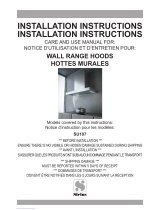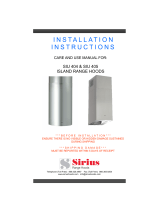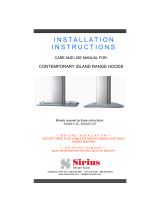Foster MILANO ISLAND 36" 2454 900 Installation Instructions Manual
- Category
- Cooker hoods
- Type
- Installation Instructions Manual
This manual is also suitable for
Foster MILANO ISLAND 36" 2454 900 is an island range hood designed to help you maintain a clean and fresh kitchen environment while cooking. It features a powerful motor that effectively removes cooking fumes, smoke, and odors from the air, leaving your kitchen smelling fresh and clean. The hood also has adjustable fan speeds, allowing you to customize the airflow to your liking. Additionally, the hood is equipped with bright LED lights that illuminate your cooking surface, making it easier to see what you're cooking.
Foster MILANO ISLAND 36" 2454 900 is an island range hood designed to help you maintain a clean and fresh kitchen environment while cooking. It features a powerful motor that effectively removes cooking fumes, smoke, and odors from the air, leaving your kitchen smelling fresh and clean. The hood also has adjustable fan speeds, allowing you to customize the airflow to your liking. Additionally, the hood is equipped with bright LED lights that illuminate your cooking surface, making it easier to see what you're cooking.




















-
 1
1
-
 2
2
-
 3
3
-
 4
4
-
 5
5
-
 6
6
-
 7
7
-
 8
8
-
 9
9
-
 10
10
-
 11
11
-
 12
12
-
 13
13
-
 14
14
-
 15
15
-
 16
16
-
 17
17
-
 18
18
-
 19
19
-
 20
20
-
 21
21
-
 22
22
-
 23
23
-
 24
24
-
 25
25
-
 26
26
-
 27
27
-
 28
28
-
 29
29
-
 30
30
-
 31
31
-
 32
32
Foster MILANO ISLAND 36" 2454 900 Installation Instructions Manual
- Category
- Cooker hoods
- Type
- Installation Instructions Manual
- This manual is also suitable for
Foster MILANO ISLAND 36" 2454 900 is an island range hood designed to help you maintain a clean and fresh kitchen environment while cooking. It features a powerful motor that effectively removes cooking fumes, smoke, and odors from the air, leaving your kitchen smelling fresh and clean. The hood also has adjustable fan speeds, allowing you to customize the airflow to your liking. Additionally, the hood is equipped with bright LED lights that illuminate your cooking surface, making it easier to see what you're cooking.
Ask a question and I''ll find the answer in the document
Finding information in a document is now easier with AI
in other languages
- français: Foster MILANO ISLAND 36" 2454 900
Related papers
Other documents
-
Bertazzoni 36 Baffle Insert Hood User manual
-
 Sirius Range Hoods SU107 Installation Instructions Manual
Sirius Range Hoods SU107 Installation Instructions Manual
-
 Sirius Range Hoods SIU401-23 User manual
Sirius Range Hoods SIU401-23 User manual
-
 Sirius Range Hoods SIU401-23 User manual
Sirius Range Hoods SIU401-23 User manual
-
 Sirius Range Hoods SIU401-23 User manual
Sirius Range Hoods SIU401-23 User manual
-
Sirius SU7 Installation guide
-
Electrolux RH36PC60GS Complete Owner's Guide (English)
-
 Sirius Range Hoods Range Hoods User manual
Sirius Range Hoods Range Hoods User manual
-
ELICA ESL636S3 Installation guide
-
DCS 221712 Installation guide




































